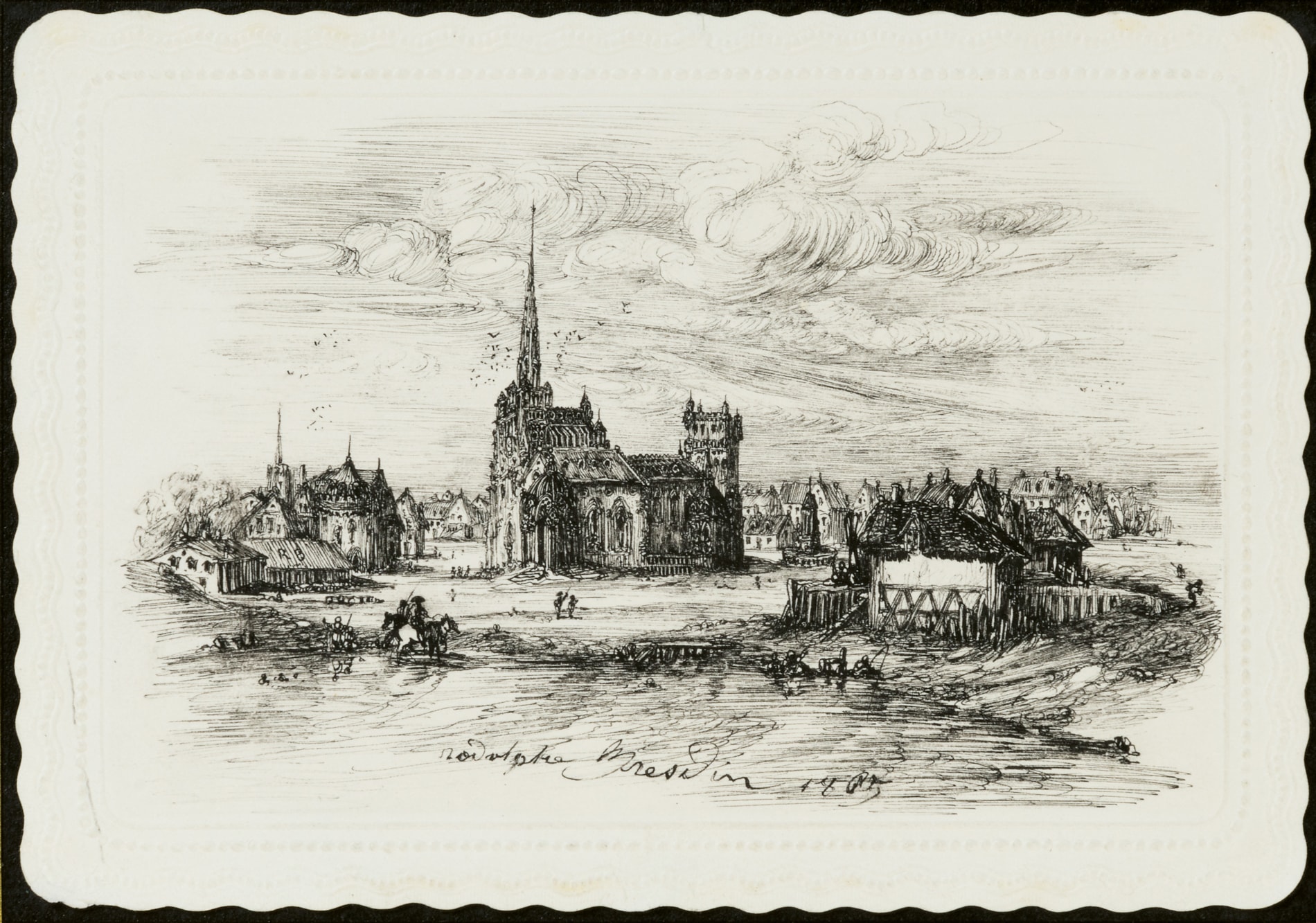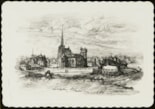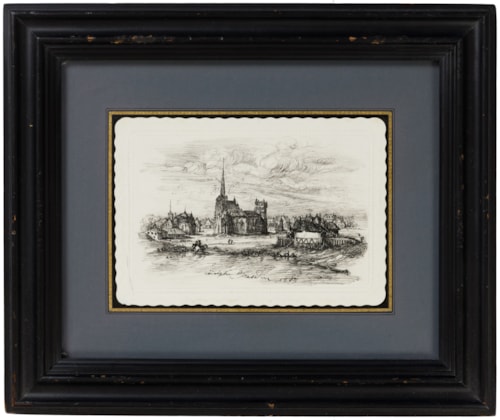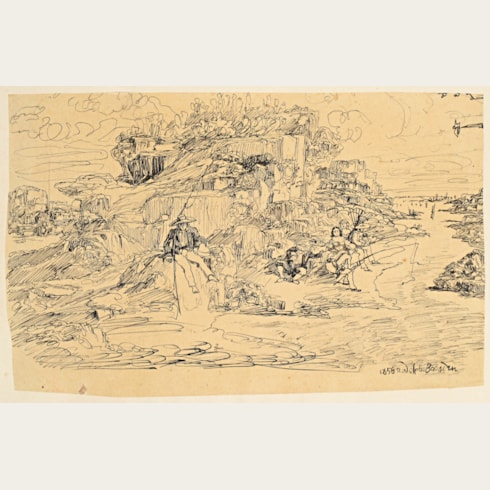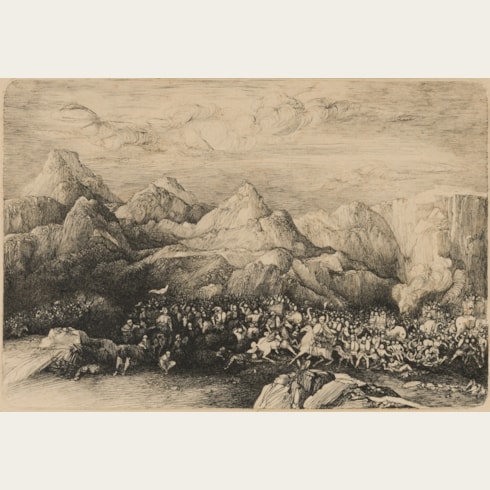Rodolphe BRESDIN
(Montrelais 1822 - Sèvres 1885)
Landscape with a Church in a Medieval Village
Sold
Pen and black ink on Bristol board with an embossed border.
Signed and dated Rodolphe Bresdin 1865 at the lower centre, and monogrammed RB on the roof of the building at the left of the composition.
84 x 129 mm. (3 1/4 x 5 in.) [image]
104 x 149 mm. (4 1/4 x 5 7/8 in.) [sheet, with embossed border]
Signed and dated Rodolphe Bresdin 1865 at the lower centre, and monogrammed RB on the roof of the building at the left of the composition.
84 x 129 mm. (3 1/4 x 5 in.) [image]
104 x 149 mm. (4 1/4 x 5 7/8 in.) [sheet, with embossed border]
Among the dominant themes in Rodolphe Bresdin’s work are scenes of figures in fantastical landscapes, peasant interiors, small villages and Biblical subjects, all depicted with an abundance of detail. Such subjects as that of the present sheet – which, like most of the artist’s drawings, is drawn with a very fine pen in a rich black ink, also known as India ink, or encre de Chine – would have been familiar to the artist from his upbringing in a village near Montrelais on the banks of the river Loire. Bresdin himself lived a peripatetic life, changing his address every few months, and his highly detailed drawings of villages, houses, farms and inns must have seemed, at times, the fabric of a world removed from his own humble existence.
Another version of this composition, of similar dimensions and likewise signed and dated 1865, was sold at auction in Germany in 2001. Of the same date is a closely related drawing of a Medieval Town with Horsemen, of identical dimensions to the present sheet and likewise on an embossed board, which was also formerly in the Mohlitz collection and recently sold at auction in France. An autograph version of the ex-Mohlitz Medieval Town with Horsemen, drawn on papier calque, is in the Bibliothèque Nationale in Paris. Several similar drawings of townscapes from the 1860s are known, such as The Church and the Port in the Metropolitan Museum of Art in New York.
The present sheet is one of several drawings by Roldolphe Bresdin owned by the 20th century French engraver Emile Philippe Magadoux, known as Philippe Mohlitz (1941-2019), who created a number of fantastical prints.
Another version of this composition, of similar dimensions and likewise signed and dated 1865, was sold at auction in Germany in 2001. Of the same date is a closely related drawing of a Medieval Town with Horsemen, of identical dimensions to the present sheet and likewise on an embossed board, which was also formerly in the Mohlitz collection and recently sold at auction in France. An autograph version of the ex-Mohlitz Medieval Town with Horsemen, drawn on papier calque, is in the Bibliothèque Nationale in Paris. Several similar drawings of townscapes from the 1860s are known, such as The Church and the Port in the Metropolitan Museum of Art in New York.
The present sheet is one of several drawings by Roldolphe Bresdin owned by the 20th century French engraver Emile Philippe Magadoux, known as Philippe Mohlitz (1941-2019), who created a number of fantastical prints.
A draughtsman and printmaker, Rodolphe Bresdin seems to have been entirely self-taught. His early career was spent in Paris, where he worked as an etcher. An eccentric, somewhat bohemian figure, he served as the inspiration for the impoverished artist-hero of Champfleury’s novel Chien-caillou, published in 1845; indeed, for most of his career Bresdin was also known by the nickname ‘Chien-Caillou’. He left Paris in 1849 for the town of Corrèze and by 1852 had settled in Toulouse, where he worked for several years. Despite living in abject poverty, this was a period of considerable productivity for the artist, who received several commissions and began to produce his first mature prints.
Although Bresdin exhibited in several Salons between 1848 and 1879, he failed to achieve much recognition or financial success. For most of the 1860’s he lived and worked in Bordeaux, where he briefly taught the young Odilon Redon, who was to become a devoted friend and champion. Bresdin emigrated to Canada in 1873 but struggled to make a living there and returned to France four years later, eventually working as a street-sweeper. In 1880, destitute and in ill-health, he abandoned his family and the following year moved into a garret in Sèvres, where he was found dead one day in January 1885. Although greatly admired by such writers as Champfleury, Baudelaire, Huysmans and Montesquieu, Bresdin’s work was first brought to public notice and acclaim at a retrospective exhibition held at the Salon d’Automne in 1908.
As no paintings by the artist have survived, Bresdin’s entire oeuvre consists of drawings, etchings and lithographs. While his graphic work is well-known today, Bresdin’s activity as a draughtsman is equally vital to an understanding of his art. Like his prints, his drawings were never on a very large scale, yet were always intricately drawn and minutely detailed.
Many of Bresdin’s drawings are finished works in pen and ink, and were created as independent works of art for exhibition or sale. However, from a career spanning some fifty years, only slightly more than four hundred drawings by Bresdin survive today, alongside a graphic oeuvre of around 160 prints. Only rarely do his drawings appear on the market, and they remain particularly scarce outside important groups of sheets in several public collections, notably the Bibliothèque Nationale in Paris, the Gemeentemuseum in The Hague and the Art Institute of Chicago; each based on collections formed by particular friends of the artist, to whom he presented his drawings.
Provenance
Emile Philippe Magadoux, called Philippe Mohlitz, Bordeaux
His posthumous sale (‘Succession de Philippe Mohlitz (1941-2019): Dessins – Sculptures - Gravures’), Bordeaux, Blanchy-Lacombe, 12 October 2019, lot 415 (as Ville de réve)
Talabardon & Gautier, Paris.
His posthumous sale (‘Succession de Philippe Mohlitz (1941-2019): Dessins – Sculptures - Gravures’), Bordeaux, Blanchy-Lacombe, 12 October 2019, lot 415 (as Ville de réve)
Talabardon & Gautier, Paris.

